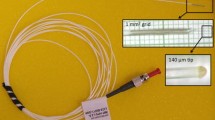Summary
A method has been developed which permits continuous recording of intratubular pressures and simultaneous infusion of test solution at rates of 0–50 nl/min through a single microcapillary. Design and operation of the system is described which consists of an ultraminiature pressure transducer, a micro-perfusion pump and the probing microcapillary. Sealing of the latter was achieved by a screw collar which permits rapid replacement of capillaries without deleterious pressure spikes. At optimal supply voltage the recorded signal was independent of input voltage changes (up to ± 100 mV) and directly proportional to a) pressure applied to the microcapillary tip and b) flow rate through the capillary. — As example the pressure increments following local infusion into the proximal convolution of indigocarmine stained saline or reabsorption inhibitors at a rate of 10 nl/min was measured. During the infusion of 10% mannitol intratubular pressure rose to a plateau and remained above control levels. Application of potassium cyanide (1.5×10−10 M/min) resulted in a gradual pressure increase starting at the onset of the intratubular perfusion. A qualitative similar rise was observed during administration of furosemide (2.2×10−11 M/min), however the effect exhibited a time delay of several minutes.
Zusammenfassung
Es wurde eine Methode entwickelt, die eine kontinuierliche Druckmessung in Rattennierentubuli bei gleichzeitiger Infusion von Testlösungen in einer Infusionsrate von 0–50 nl/min ermöglicht. Aufbau und Arbeitsweise des Systems, welches aus einem Ultraminiatur-Druckaufnehmer, einer Mikroperfusionspumpe und einer Mikropunktionscapillare besteht, werden beschrieben. Die Dichtung der Punktionscapillaren erfolgt über einen Schlitzkonus, der die einfache und sichere Auswechslung erlaubt und die Gefahr von kritischen Druckentwicklungen während der Capillarmontage ausschaltet. Im Bereich optimaler Betriebs-spannung war das Registriersignal unabhängig von Spannungsschwankungen (um±100 mV); ferner war es direkt proportional a) dem Druckanstieg an der Capillarspitze durch Gegendruck und b) der Strömungsrate durch die Capillarspitze. — Als Anwendungsbeispiele werden Druckregistrierungen bei direkter Infusion von Indigocarmin-gefärbter Kochsalzlösung und von Resorptionshemmern in das proximale Konvolut (10 nl/ml) mitgeteilt. 10% Mannit bedingt einen Anstieg des intratubularen Druckes über das Kontrollplateau. K-Cyanide (1,5×10−10 M/min) führt zu einer kontinuierlichen Druckzunahme, ebenso Furosemid (2,2×10−11 M/min), letzteres jedoch mit einer zeitlichen Verzögerung von mehreren Minuten.
Similar content being viewed by others
Abbreviations
- P :
-
Pressure on pressure sensitive diaphragm (gauge pressure) in cm H2O
- P tub :
-
Intratubular pressure
- ΔP tub :
-
Rise of intratubular pressure, when perfusion is turned on
- P x :
-
Pressure due to resistance of capillary tip;
- Φ:
-
Perfusion rate (nl/ml)
- R :
-
Flow resistance of capillary tip, measured either in the aqueous phase on the kidney (R surface) or in the tubular lumen (R lumen)
- U (P=O):
-
Zero pressure output voltage
- f.s.:
-
Full scale
References
Gottschalk, C. W., Mylle, M.: Micropuncture study of pressures in proximal tubules and peritubular capillaries of the rat kidney and their relation to ureteral and renal venous pressures. Amer. J. Physiol.185, 430 (1956).
Hierholzer, K., Wiederholt, M., Stolte, H.: Hemmung der Natriumresorption im proximalen und distalen Konvolut adrenalektomierter Ratten. Pflügers Arch. ges. Physiol.291, 43 (1966).
Landis, E. M.: The capillary pressure in frog mesentery as determined by micro-injection methods. Amer. J. Physiol.75, 548 (1926).
Wirz, H.: Druckmessungen in Kapillaren und Tubuli der Niere durch Mikropunktion. Helv. physiol. pharmacol. Acta13, 42 (1955).
Wunderlich, P., Schnermann, J.: Continuous recording of hydrostatic pressure in renal tubules and blood capillaries by use of a new pressure transducer. Pflügers Arch. ges. Physiol.313, 89 (1969).
Author information
Authors and Affiliations
Additional information
Mit Unterstützung durch die Deutsche Forschungsgemeinschaft.
Rights and permissions
About this article
Cite this article
Lohfert, H., Lichtenstein, I., Butz, M. et al. Continuous measurement of renal intratubular pressures with a combined pressure transducer microperfusion system. Pflugers Arch. 327, 191–202 (1971). https://doi.org/10.1007/BF00586858
Received:
Issue Date:
DOI: https://doi.org/10.1007/BF00586858




